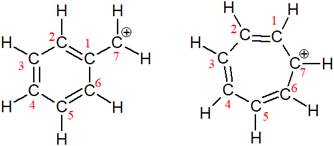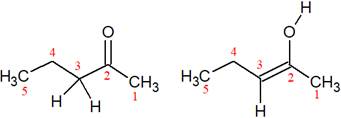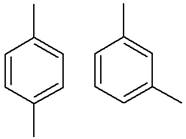
Concept explainers
(a)
Interpretation:
It is to be determined if the given pair is not resonance structures of one another.
Concept introduction:
Resonance exists in species for which there are two or more valid Lewis structures. Resonance structures differ only in the placement of their electrons, not their atoms. Resonance stabilization is usually high when the resonance contributors are equivalent. More the number of the resonance contributors, the more is the resonance stabilization.
Answer to Problem 1.75P
The given structures are not resonance structures of one another.
Explanation of Solution
The structures of the given pair are shown below:

The two structures have completely different carbon skeleton. The first one has a six membered ring while the second has a seven membered ring. Since these two structures do not have the same position of the atoms, they cannot be resonance structures.
From the position of atoms and electrons, it is found that the given pair is not resonance structures of one another.
(b)
Interpretation:
It is to be determined if the given pair is not resonance structures of one another.
Concept introduction:
Resonance exists in species for which there are two or more valid Lewis structures. Resonance structures differ only in the placement of their electrons, not their atoms. Resonance stabilization is usually high when the resonance contributors are equivalent. More the number of the resonance contributors, the more is the resonance stabilization.
Answer to Problem 1.75P
The given structure is not resonance structures of one another.
Explanation of Solution
The structures of the given pair are shown below:

In these two structures, the position of the hydrogen atoms is not the same. Hence, these structures cannot be resonance structures of each other.
From the position of atoms and valence electrons, it is found that the given pair is not resonance structures of one another.
(c)
Interpretation:
It is to be determined if the given pair is not resonance structures of one another.
Concept introduction:
Resonance exists in species for which there are two or more valid Lewis structures. Resonance structures differ only in the placement of their electrons, not their atoms. Resonance stabilization is usually high when the resonance contributors are equivalent. More the number of the resonance contributors, the more is the resonance stabilization.
Answer to Problem 1.75P
The given structure is resonance structures of one another.
Explanation of Solution
The structures of the given pair are as shown below.

To obtain the second resonance structure, two curved arrows are drawn and the electrons are moved accordingly. The two structures differ only in the placement of their electrons, not their atoms. Therefore, the given pair is resonance structures of one another.
From the position of atoms and valence electrons, it is found that the given pair is resonance structures of one another.
(d)
Interpretation:
It is to be determined if the given pair is not resonance structures of one another.
Concept introduction:
Resonance exists in species for which there are two or more valid Lewis structures. Resonance structures differ only in the placement of their electrons, not their atoms. Resonance stabilization is usually high when the resonance contributors are equivalent. More the number of the resonance contributors, the more is the resonance stabilization.
Answer to Problem 1.75P
The given structure is resonance structures of one another.
Explanation of Solution
The structures of the given pair are shown below:

To obtain the second resonance structure, two curved arrows are drawn and the valence electrons are moved accordingly. Similarly, to arrive at the third resonance structure, two curved arrows are drawn and valence electrons are moved accordingly. The resonance structures differ only in the placement of their electrons, not their atoms. Therefore, the given pair is resonance structures of one another.
From the position of atoms and valence electrons, it is found that the given pair is resonance structures of one another.
(e)
Interpretation:
It is to be determined if the given pair is not resonance structures of one another.
Concept introduction:
Resonance exists in species for which there are two or more valid Lewis structures. Resonance structures differ only in the placement of their electrons, not their atoms. Resonance stabilization is usually high when the resonance contributors are equivalent. More the number of the resonance contributors, the more is the resonance stabilization.
Answer to Problem 1.75P
The given structure is resonance structures of one another.
Explanation of Solution
The structures of the given pair are shown below:
![]()
To obtain the second resonance structure, a curved arrow is drawn and the valence electrons are moved accordingly. Similarly, to arrive at the third resonance structure, two curved arrows are drawn and valence electrons are moved accordingly. The resonance structures differ only in the placement of their electrons, not their atoms. Therefore, the given pair is resonance structures of one another.
From the position of atoms and valence electrons, it is found that the given pair is resonance structures of one another.
(f)
Interpretation:
It is to be determined if the given pair is not resonance structures of one another.
Concept introduction:
Resonance exists in species for which there are two or more valid Lewis structures. Resonance structures differ only in the placement of their electrons, not their atoms. Resonance stabilization is usually high when the resonance contributors are equivalent. More the number of the resonance contributors, the more is the resonance stabilization.
Answer to Problem 1.75P
The given structure is not resonance structures of one another.
Explanation of Solution
The structure of the given pair is as follows:

Resonance structures differ only in the placement of their electrons, not their atoms. In the given pair, the placement of electrons is the same. Therefore, the given pair is not resonance structures of one another.
From the position of atoms and valence electrons, it is found that the given pair is not resonance structures of one another.
(g)
Interpretation:
It is to be determined if the given pair is not resonance structures of one another.
Concept introduction:
Resonance exists in species for which there are two or more valid Lewis structures. Resonance structures differ only in the placement of their electrons, not their atoms. Resonance stabilization is usually high when the resonance contributors are equivalent. More the number of the resonance contributors, the more is the resonance stabilization.
Answer to Problem 1.75P
The given structure is not resonance structures of one another.
Explanation of Solution
The structure of the given pair is as follows:

Resonance structures differ only in the placement of their electrons, not their atoms. In the given pair, the placement of electrons is the same. Therefore, the given pair is not resonance structures of one another.
From the position of atoms and valence electrons, it is found that the given pair is resonance structures of one another.
(h)
Interpretation:
It is to be determined if the given pair is not resonance structures of one another.
Concept introduction:
Resonance exists in species for which there are two or more valid Lewis structures. Resonance structures differ only in the placement of their electrons, not their atoms. Resonance stabilization is usually high when the resonance contributors are equivalent. More the number of the resonance contributors, the more is the resonance stabilization.
Answer to Problem 1.75P
The given structure is not resonance structures of one another.
Explanation of Solution
The structure of the given pair is as follows:

Resonance structures differ only in the placement of their electrons, not their atoms. In the given pair, the placement of electrons is different; at the same time, one H atom changes its position. Therefore, the given pair is not resonance structures of one another.
From the position of atoms and valence electrons, it is found that the given pair is not resonance structures of one another.
Want to see more full solutions like this?
Chapter 1 Solutions
EBK ORGANIC CHEMISTRY: PRINCIPLES AND M
- Q5: Label each chiral carbon in the following molecules as R or S. Make sure the stereocenter to which each of your R/S assignments belong is perfectly clear to the grader. (8pts) R OCH 3 CI H S 2pts for each R/S HO R H !!! I OH CI HN CI R Harrow_forwardCalculate the proton and carbon chemical shifts for this structurearrow_forwardA. B. b. Now consider the two bicyclic molecules A. and B. Note that A. is a dianion and B. is a neutral molecule. One of these molecules is a highly reactive compound first characterized in frozen noble gas matrices, that self-reacts rapidly at temperatures above liquid nitrogen temperature. The other compound was isolated at room temperature in the early 1960s, and is a stable ligand used in organometallic chemistry. Which molecule is the more stable molecule, and why?arrow_forward
- A mixture of C7H12O2, C9H9OCl, biphenyl and acetone was put together in a gas chromatography tube. Please decide from the GC resutls which correspond to the peak for C7,C9 and biphenyl and explain the reasoning based on GC results. Eliminate unnecessary peaks from Gas Chromatography results.arrow_forwardIs the molecule chiral, meso, or achiral? CI .CH3 H₂C CIarrow_forwardPLEASE HELP ! URGENT!arrow_forward
- Identify priority of the substituents: CH3arrow_forwardHow many chiral carbons are in the molecule? OH F CI Brarrow_forwardA mixture of three compounds Phen-A, Acet-B and Rin-C was analyzed using TLC with 1:9 ethanol: hexane as the mobile phase. The TLC plate showed three spots of R, 0.1 and 0.2 and 0.3. Which of the three compounds (Phen-A; Acet-B or Rin-C) would have the highest (Blank 1), middle (Blank 2) and lowest (Blank 3) spot respectively? 0 CH: 0 CH, 0 H.C OH H.CN OH Acet-B Rin-C phen-A A A <arrow_forward
 World of Chemistry, 3rd editionChemistryISBN:9781133109655Author:Steven S. Zumdahl, Susan L. Zumdahl, Donald J. DeCostePublisher:Brooks / Cole / Cengage Learning
World of Chemistry, 3rd editionChemistryISBN:9781133109655Author:Steven S. Zumdahl, Susan L. Zumdahl, Donald J. DeCostePublisher:Brooks / Cole / Cengage Learning Chemistry: The Molecular ScienceChemistryISBN:9781285199047Author:John W. Moore, Conrad L. StanitskiPublisher:Cengage Learning
Chemistry: The Molecular ScienceChemistryISBN:9781285199047Author:John W. Moore, Conrad L. StanitskiPublisher:Cengage Learning

